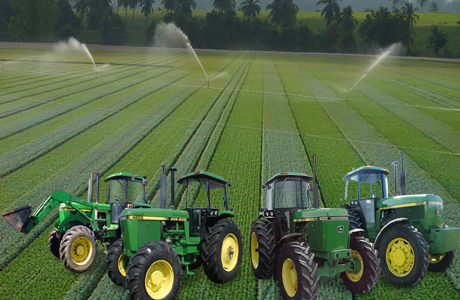Issues in farm mechanisation
By Mohiuddin Aazim
 Despite
its vital role in modernisation of farming and in raising
its productivity, the pace of balanced and integrated farm
mechanisation is slow.
Despite
its vital role in modernisation of farming and in raising
its productivity, the pace of balanced and integrated farm
mechanisation is slow.
The reasons are many: lack of policy direction, low bank
lending for agricultural development and poor state of local
agricultural machinery manufacturing.
Successive governments have focused on launching &
re-launching subsidised tractors’ schemes for farm
mechanisation while solar-powered tubewells and drip
irrigation and sprinkler systems have virtually been on the
back burner but for some initiatives in recent years.
No doubt, the tractor schemes have helped mechanisation of
farming. About 76pc farmers now cultivate land with
tractors, 20pc with tractors and draught animals—and only
4pc use draught animals alone, official stats reveal.
Pakistan Bureau of Statistics, in coordination with the
provincial governments, gathers stats also on, tubewells and
lift pumps, cultivators, mould board plough, bar/disk
harrows, disk plough, furrowers and trolleys and trailers.
And when one compares their latest counting (of 2010) with
the previous one (of 2004) one actually see a growing trend
in their usage.
But generally speaking, farm mechanisation is still at an
early stage.
And, this is one of the key factors responsible for keeping
agriculture where it is now—rise in per-acre yield is low
and slow, pre and post-harvest losses are huge and
processing, grading and packaging of agricultural produce is
wanting on many counts.
A study conducted by the University of Agriculture,
Faisalabad, found a few years ago that in large parts of
Punjab wheat growers use lesser than recommended number of
machines which affects the crop yield. The same can be said
about growers of major crops in parts of other provinces as
well.
“One important reason for this is that a majority of
farmers, particularly with small land holdings, don’t know
how to prioritise input spending”, says a former secretary
of Sindh agriculture department. “
Banks’ low lending for agricultural machinery, and
unorganised nature of agricultural manufacturing also hinder
promotion of farm mechanisation.”
Successive governments have
focused on launching and re-launching subsidised tractors’
schemes for farm mechanisation while solar-powered tubewells
and drip irrigation and sprinkler systems have been on the
back burner but for some initiatives in recent years.
In FY14, banks’ agricultural lending at Rs391.4bn exceeded
the target of Rs380bn but, according to a SBP report, “banks
were able to meet only 50pc of the overall demand of Rs790bn
estimated for the year.”
Worse still, less than 5pc of
the disbursed credit volumes went in financing for
agricultural machinery and implements.
Agriculturists say that farm mechanisation cannot be
promoted without developing comprehensive data base—and, of
course, a well-integrated policy.
Development of a detailed
database is crucial to help policymakers understand the
current status of farm mechanisation and identify the areas
where improvement is required.
Per-acre output of food and non-food crops tend to rise with
increase in the area under cultivation because of economy of
scale in inputs’ cost that comes along with it. Better seeds
and proper care of crops also boost per-acre yields. But
farming machines work wonders.
Farmers, for example, point out that mechanised broadcast
seed-sowing gives more even distribution of seeds across the
field and leads to higher yields.
But they lament that
manufacturing of this kind of machinery is almost missing
and imports prove costly.
They say that instead of just
providing subsidy on tractors, provincial governments should
give subsidy on a wider range of agricultural machinery.
They suggest that in order to ensure economic return of such
a subsidy, the distribution of subsidised agricultural
machinery can even be linked with some performance criteria.
Growers and agricultural officials say that production of
farm machinery is not undertaken after proper research on
market requirements. Besides, many locally produced machines
are of poor quality, have short work life and, thus,
uneconomical.
Market sources say around 100 companies are involved in
manufacturing and trading of agricultural machinery and
implements, though the number of the companies registered
with the SECP is far higher.
They say that most of even
these 100 companies are focused on imports or trade and just
30 or are engaged in regular manufacturing.
One way of accelerating farm mechanisation is through shared
use of machinery on a larger scale and in an organised
manner, agriculturists say. Renting and commercial sharing
of agricultural machinery is quite common.
But this has been the
practice of very small local groups of farmers and that,
too, in an informal manner.
In the last two fiscal years, Punjab and Sindh have provided
25,000 tractors on subsidised rates to growers which has
helped them boost their farm produce to some extent.
Growers say, the two
governments, should now find ways to institutionalise shared
use of not only subsidised tractors but also of other farm
machinery and implements on the pattern of rotating use of
subsidised solar-powered tube-wells.
Officials point out that subsidised solar-powered tubewells
are being installed at farm fields in many districts of
Balochistan and Punjab which are widening the scope of farm
mechanisation.
The Punjab provincial
government is making some progress also towards promoting
economic use of water. In the last fiscal year, the
government installed subsidised drip and sprinkler
irrigation system on 2,200 acres of land as part of a
foreign-funded project.
This year, the target is to
install this system on 4,500 acres of land. Growers,
however, say the scale of the project is too small and it
will take many years to get some real benefit in terms of
economic use of water.
December 2014
Courtesy:
Dawn News